Association between Land Surface Temperature and Green Volume in Bochum, Germany
Abstract
1. Introduction
1.1. The Formation and Properties of Urban Heat Islands
1.2. Green Spaces, Green Area, and Green Volume
1.3. Problem, Aims, Case Study, and Study Design
1.3.1. Case Study: Bochum, Germany
1.3.2. Research Questions and Study Design
- How does the green volume affect surface heat islands in Bochum?
- a.
- Does the spatial pattern resemble a heat island or a heat archipelago?
- b.
- What is the correlation between LST and GV?
- c.
- What are the contributions of a vertical structure and type of green space on LST?
- c.
- How do SHI distributions across urban districts relate to human populations?
2. Materials and Methods
2.1. Remote Sensing Data to Support LST Anlysis
2.2. LST Time-Series Calculation Procedure
2.3. Green Volume Calculation Procedure
- Use of an NDVI mask to isolate vegetation;
- Development of a normalized digital surface (Oberfläche in German) model (nDOM) that contains heights of all objects between the soil and atmosphere within the NDVI envelope;
- Postprocessing of nDOM to remove outliers or confounding objects;
- Generation of the ‘vegetation nDOM’ as GV.
2.3.1. NDVI Vegetation Mask
2.3.2. Generation of a Normalized Digital Surface Model (nDOM)
2.3.3. DTM and DOM Data Processing
2.3.4. Postprocessing and Creation of the Vegetation nDOM (GV)
2.4. Statistical Analysis of Heat Island and Green Volume
3. Results
3.1. LST Analysis
3.2. Green Volume Distribution
3.3. Statistical Association of Green Volume and Heat Islands in Bochum
3.4. Contribution of Green Space Typology on LST
4. Discussion
4.1. Drawbacks to the Study
4.2. Future Research Directions
Author Contributions
Funding
Institutional Review Board Statement
Informed Consent Statement
Data Availability Statement
Conflicts of Interest
References
- Weber, N.; Haase, D.; Franck, U. Zooming into temperature conditions in the city of Leipzig: How do urban built and green structures influence earth surface temperatures in the city? Sci. Total Environ. 2014, 496, 289–298. [Google Scholar] [CrossRef] [PubMed]
- Kapustina, D.; Klug, J. Erhöhung der Albedo von Stadtoberflächen als Maßnahme um die städtische Wärmeinsel zu mildern: Die „Insulaner“—Ursachen und Variabilität der Städtischen Wärmeinsel und ihre Auswirkungen auf den Menschen. 2011. Available online: https://www.klima.tu-berlin.de/insulaner/sites/default/files/2018-08/A1_Endabgabe_Literaturstudie_Klug_Kapustina_word_08.pdf (accessed on 14 October 2021).
- Bundesinstitut für Bau-, Stadt- und Raumforschung (BBSR) im Bundesamt für Bauwesen und Raumordnung (BBR). Klimawandelgerechte Stadtentwicklung: Ursachen und Folgen des Klimawandels durch urbane Konzepte begegnen; ein Projekt des Forschungsprogramms "Experimenteller Wohnungs- und Städtebau (ExWoSt)" des Bundesministeriums für Verkehr, Bau und Stadtentwicklung (BMVBS), betreut vom Bundesinstitut für Bau-, Stadt- und Raumforschung (BBSR) im Bundesamt für Bauwesen und Raumordnung (BBR); Greiving, S., Ed.; Bundesamt für Bauwesen und Raumordnung: Bonn, Germany, 2011; ISBN 978-3-87994-481-1.
- Jendritzky, G. Folgen des Klimawandels für die Gesundheit. 2007. Available online: https://edoc.hu-berlin.de/bitstream/handle/18452/2633/108.pdf?sequence=1 (accessed on 14 October 2021).
- Wiener Gewässer Management GmbH. WAS IST EINE HITZEINSEL? Available online: https://markthalle.wienwirdwow.at/2021/03/31/hitzeinseln/ (accessed on 8 September 2021).
- Brandenburg, C.; Damyanovic, D.; Reinwald, F.; Allex, B.; Gantner, B.; Czachs, C. Urban Heat Islands: Strategieplan Wien. 2015. Available online: https://www.wien.gv.at/umweltschutz/raum/pdf/uhi-strategieplan-druck.pdf (accessed on 8 September 2021).
- BMUB; Referat SW I 7; Eyink, H.; Heck, B. Grün in der Stadt −Für eine lebenswerte Zukunft: Grünbuch Stadtgrün. 2015. Available online: https://www.bmi.bund.de/SharedDocs/downloads/DE/publikationen/themen/bauen/wohnen/gruenbuch-stadtgruen.pdf?__blob=publicationFile&v=3 (accessed on 8 September 2021).
- LANUV. Stadtklima. Available online: https://www.lanuv.nrw.de/klima/klimaanpassung-in-nrw/stadtklima (accessed on 10 December 2021).
- Meinel, G.; Schumacher, U. (Eds.) Flächennutzungsmonitoring II: Konzepte, Indikatoren, Statistik, [Beiträge des 2. Dresdner Flächennutzungssymposiums; IÖR-Bschriften, Bd. 52.; Rhombos-Verlag: Berlin, Germany, 2010; ISBN 978-3-941216-47-1. [Google Scholar]
- TMUEN. Rückstrahlung von Bau- und Gestaltungsmaterialien. Available online: https://www.klimaleitfaden-thueringen.de/rueckstrahlung-von-bau-und-gestaltungsmaterialien (accessed on 15 November 2021).
- Müskens, A. Die Wärmeinsel der Stadt Münster: Ausdehnung, Intensität und Belüftungssituation. Diploma Thesis, Westfälische Wilhelms-Universität Münster, Münster, Germany, 2004. [Google Scholar]
- Betschart, M. Städtischer Wärmeinsel-Effekt: Grundlagenarbeit für die Klimarisikoanalysen 2060. 2015. Available online: https://www.google.com/search?rlz=1C1CHBF_deDE885DE885&sxsrf=AOaemvIT_Ubw2AbdNALVBXj3r8kcdXt6HQ:1641306395855&q=St%C3%A4dtischer+W%C3%A4rmeinseleffekt+mario+betschart&spell=1&sa=X&ved=2ahUKEwjotMTlppj1AhVMSPEDHQWBCZcQBSgAegQIARA2&biw=958&bih=927&dpr=1# (accessed on 12 October 2021).
- Deutscher Wetterdienst. Mesoklima: Wetter- und Klimalexikon. Available online: https://www.dwd.de/DE/service/lexikon/Functions/glossar.html?lv2=101640&lv3=101726 (accessed on 16 November 2021).
- Matzarakis, A. Stadtklima vor dem Hintergrund des Klimawandels. In Gefahrstoffe-Reinhaltung der Luft; Deutsche Gesetzliche Unfallversicherung e.V. (DGUV): Berlin, Germany, 2013; pp. 115–118. [Google Scholar]
- Taubenböck, H.; Wurm, M.; Esch, T.; Dech, S.; Wanka, J.; Wörner, J.-D. (Eds.) Globale Urbanisierung: Perspektive aus dem All; Springer Spektrum: Berlin, Germany, 2015; ISBN 978-3-662-44840-3. [Google Scholar]
- Deutscher Wetterdienst. Mikroklima: Wetter- und Klimalexikon. Available online: https://www.dwd.de/DE/service/lexikon/Functions/glossar.html?lv2=101640&lv3=101778 (accessed on 16 November 2021).
- Kuttler, W. The Urban Climate—Basic and Applied Aspects: Urbanes Klima. In Gefahrstoffe—Reinhaltung der Luft; Deutsche Gesetzliche Unfallversicherung e.V. (DGUV): Berlin, Germany, 2008; pp. 329–340. [Google Scholar]
- Henninger, S.; Fabisch, M. Siedlungsgebundene Unterflur-Überwärmung und deren Risikopotenzial für Infrastruktur und Gesundheit. In Is This the Real World?: Perfect Smart Cities vs. Real Emotional Cities: Proceedings of the 24th International Conference on Urban Planning, Regional Development and Information Society; CORP—Competence Center of Urban and Regional Planning: Wien, Austria, 2019; pp. 637–644. ISBN 978-3-9504173-7-1. [Google Scholar]
- Tiller, N. Urbaner Hitzeinseleffekt und Altersspezifische Vulnerabilität—Eine Typisierung von Raumeinheiten in Wien. Master’s Thesis, Universität Wien, Wien, Austria, 2015. [Google Scholar]
- GDV Gesamtverband der Deutschen Versicherungswirtschaft e.V. Mün chen ist die am Stärks Ten ver sie Gelte Groß stadt: Ver sie ge lungs stu die. Available online: https://www.gdv.de/de/medien/aktuell/muenchen-ist-die-am-staerksten-versiegelte-grossstadt-36418 (accessed on 16 September 2021).
- Masson-Delmotte, V.; Zhai, P.; Pirani, A.; Connors, S.L.; Péan, C.; Berger, S.; Zhou, B. (Eds.) Climate Change 2021: The Physical Science Basis: Contribution of Working Group I to the Sixth Assessment Report of the Intergovernmental Panel on Climate Change, 2.; Cambridge University Press: Cambridge, UK; New York, NY, USA, 2021. [Google Scholar]
- Hackenbruch, J. Anpassungsrelevante Klimaänderungen für Städtische Baustrukturen und Wohnquartiere. Ph.D. Thesis, Karlsruher Institut für Technologie (KIT), Karlsruhe, Germany, 2018. [Google Scholar]
- Klockau, A. Hitze in der Stadt mit Mehr Weiß, Grün und Blau Verringern. Available online: https://www.br.de/nachrichten/wissen/hitze-in-der-stadt-mit-mehr-weiss-gruen-und-blau-verringern,RXKYznH (accessed on 4 November 2021).
- Ministerium für Wirtschaft, Arbeit und Wohnungsbau. Charakteristik und Erscheinungsformen des Stadtklimas: Urbane Wärmeinseln. Available online: https://www.staedtebauliche-klimafibel.de/?p=6&p2=2.3 (accessed on 8 November 2021).
- Nagel, A.; Schulz, J.; Stratenwerth, T. Dem Klimawandel begegnen: Die Deutsche Anpassungsstrategie. 2009. Available online: https://www.umweltbundesamt.de/sites/default/files/medien/515/dokumente/broschuere_dem_klimawandel_begegnen_bf.pdf (accessed on 28 October 2021).
- Deutscher Wetterdienst. Evapotranspiration: Klimafolgenmonitoring. Available online: https://www.lanuv.nrw.de/kfm-indikatoren/index.php?indikator=26&aufzu=2&mode=indi (accessed on 15 November 2021).
- Willig, H.-P. Oberflächentemperatur. Available online: https://www.cosmos-indirekt.de/Physik-Schule/Oberfl%C3%A4chentemperatur (accessed on 5 January 2022).
- Bokaie, M.; Zarkesh, M.K.; Arasteh, P.D.; Hosseini, A. Assessment of Urban Heat Island based on the relationship between land surface temperature and Land Use/Land Cover in Tehran. Sustain. Cities Soc. 2016, 23, 94–104. [Google Scholar] [CrossRef]
- Klok, L.; Zwart, S.; Verhagen, H.; Mauri, E. The surface heat island of Rotterdam and its relationship with urban surface characteristics. Resour. Conserv. Recycl. 2012, 64, 23–29. [Google Scholar] [CrossRef]
- Claßen, T. Urbane Grün- und Freiräume—Ressourcen einer gesundheitsförderlichen Stadtentwicklung. In Planung für gesundheitsfördernde Städte; Baumgart, S., Köckler, H., Ritzinger, A., Rüdiger, A., Eds.; ARL: Hannover, Germany, 2018; pp. 297–313. [Google Scholar]
- Landeshauptstadt Potsdam. Umweltmonitoring Potsdam. 2018. Available online: https://vv.potsdam.de/vv/Umweltmonitoring_-_Flyer_Dez2018.pdf (accessed on 28 October 2021).
- Meinel, G.; Hecht, R.; Socher, W. Städtisches Grünvolumen—Neuer Basisindikator für die Stadtökologie? Bestimmungsmethodik und Ergebnisbewertung. In Sustainable Solutions for the Information Society: Proceedings of 11th International Conference on Urban Planning and Spatial Development in the Information Society; CORP 2006 & GEO MULTIMEDIA 06; Schrenk, M., Ed.; Selbstverl des Vereins CORP Competence Center for Urban and Regional Development: Wien, Austria, 2006; pp. 685–694. ISBN 978-3-9502139-0-4. [Google Scholar]
- Projektgruppe Stadtnatur Hamburg. Das Grünvolumen. Available online: http://www.isebek-initiative.de/archives/32-Gruenvolumen-zur-Klimaanpassung.html (accessed on 28 October 2021).
- Weber, C.; Keller, D.; Brechtold, M.; Krass, P.; Dragaj, P.Q.; Trute, P.; Lessmann, D.; Meusel, G. Hitze in Städten: Grundlage für eine klimaangepasste Siedlungsentwicklung. 2018. Available online: https://www.are.admin.ch/dam/are/de/dokumente/agglomerationspolitik/publikationen/hitze-in-staedten-de.pdf.download.pdf/Hitze_in_Staedten_de.pdf (accessed on 3 January 2022).
- Kotremba, C.; Kleber, A. Klimagerechte Stadtentwicklung: Hintergrundpapier. 2019. Available online: https://www.kwis-rlp.de/fileadmin/website/klimakompetenzzentrum/Klimawandelinformationssystem/Anpassungsportal/Anpassungscoach/Klimagerechte_Stadtentwicklung.pdf (accessed on 8 September 2021).
- Stadt Bochum. Die wichtigsten zahlen zur Bochumer Bevölkerung: Statistik. Available online: https://www.bochum.de/Referat-fuer-politische-Gremien-Buergerbeteiligung-und-Kommunikation/Statistik/Die-wichtigsten-Zahlen-zur-Bochumer-Bevoelkerung (accessed on 17 November 2021).
- Tulun, B. Klima in Bochum. Available online: https://klima.org/deutschland/klima-bochum/ (accessed on 3 November 2021).
- Weatherspark. Klima und durchschnittliches Wetter das ganze Jahr über in Bochum. Available online: https://de.weatherspark.com/y/58248/Durchschnittswetter-in-Bochum-Deutschland-das-ganze-Jahr-%C3%BCber (accessed on 3 November 2021).
- Steinrücke, M. Klimaanpassungskonzept Bochum. 2012. Available online: https://geodatenportal.bochum.de/bogeo/web/61/doku/klimaanpassungskonzept.pdf (accessed on 3 November 2021).
- DLR. Land Surface Temperature (LST). Available online: https://www.dlr.de/eoc/desktopdefault.aspx/tabid-9140/19508_read-45422/ (accessed on 4 November 2021).
- ITTVIS. ENVI—Image Processing and Analysis Software Solution. Available online: https://www.ittvis.com/envi/ (accessed on 5 January 2022).
- Bittner, M.; Baier, F.; Erbertseder, T.; Gesell, G.; Hünther, K.; Holzer-Popp, T.; Schroedter, M.; Trautmann, T.; Loyola, D.; Mayer, B. Satellitenbasierte Fernerkundung klimarelevanter Parameter in der Atmosphäre im Deutschen Zentrum für Luft und Raumfahrt, DLR. 2004. Available online: https://gcos.dwd.de/DE/leistungen/klimastatusbericht/publikationen/ksb2004_pdf/02_2004.pdf?__blob=publicationFile&v=1 (accessed on 4 November 2021).
- Spektrum. Elektromagnetische Strahlung. Available online: https://www.spektrum.de/lexikon/physik/elektromagnetische-strahlung/4055 (accessed on 5 November 2021).
- Baldenhofer, K. Das Lexikon der Fernerkundung. Available online: https://www.fe-lexikon.info/index.htm (accessed on 2 November 2021).
- Fakultät für Physik. Fernerkundung: Katastrophenmonitoring Mittels Satelliten. Available online: https://www.sattec.org/satellitenfernerkundung/index.html (accessed on 9 December 2021).
- Sohail, M.; Ali, S.S.F.; Fatima, E.; Nawaz, D.A. Spatio-temporal analysis of land use dynamics and its potential implications on land surface temperature in lahore district, punjab, pakistan. Int. Arch. Photogramm. Remote Sens. Spatial Inf. Sci. 2021, XLIII-B3-2021, 359–367. [Google Scholar] [CrossRef]
- Honecker, U.; Löffler, E. Fernerkundung. In Handwörterbuch der Stadt- und Raumentwicklung; Ausgabe 2018; Akademie für Raumforschung und Landesplanung: Hannover, Germany, 2018; pp. 655–660. ISBN 978-3-88838-559-9. [Google Scholar]
- De Lange, N. Geoinformatik in Theorie und Praxis: Grundlagen von Geoinformationssystemen, Fernerkundung und digitaler Bildverarbeitung; Springer Spektrum: Berlin/Heidelberg, Germany, 2020; ISBN 978-3-662-60708-4. [Google Scholar]
- U.S. Geological Survey. Using the USGS Landsat Level-1 Data Product: Landsat Missions. Available online: https://www.usgs.gov/core-science-systems/nli/landsat/using-usgs-landsat-level-1-data-product (accessed on 2 November 2021).
- Butler, K. Deriving Temperature from Landsat 8 Thermal Bands. Available online: https://www.esri.com/arcgis-blog/products/product/analytics/deriving-temperature-from-landsat-8-thermal-bands-tirs/?rmedium=redirect&rsource=blogs.esri.com/esri/arcgis/2014/01/06/deriving-temperature-from-landsat-8-thermal-bands-tirs (accessed on 2 November 2021).
- Singh, R.B.; Srinagesh, B.; Anand, S. (Eds.) Urban Health Risk and Resilience in Asian Cities, 1st ed.; Springer: Singapore, 2020; ISBN 978-981-15-1204-9. [Google Scholar]
- Nichol, J. An Emissivity Modulation Method for Spatial Enhancement of Thermal Satellite Images in Urban Heat Island Analysis. Photogramm. Eng. Remote Sens. 2009, 75, 547–556. [Google Scholar] [CrossRef]
- Schneider, D. Bestimmung der Emissivität von Oberächen auf Basis Bildgebender Verfahren. Available online: https://tu-dresden.de/bu/umwelt/geo/ipf/photogrammetrie/studium/finished_theses/abgeschlosseneArbeiten/2014/2014_BA_rulf (accessed on 2 November 2021).
- Westebbe, P. Untersuchungen an Kunst- und Kulturgut Mittels der Infrarot-Thermografie—Eine Zerstörungsfreie Analysemethode. Diploma Thesis, Technische Universität München, München, Germany, 2004. [Google Scholar]
- Grudzielanek, A.M. Thermographische Erfassung und Analyse katabatischer Strömungen. Ph.D. Thesis, Ruhr-Universität Bochum, Bochum, Germany, 2013. [Google Scholar]
- Weber, N. Meso- und mikroskalige Untersuchungen der Landoberflächentemperaturen von Berlin. Ph.D. Thesis, Humboldt-Universität zu Berlin, Berlin, Germany, 2009. [Google Scholar]
- Hoechstetter, S.; Wende, W. Digitale Stadtstrukturkartierung—Analyse der stadtstrukturellen Grundlagen und thermale Charakterisierung von Stadtstrukturen. 2011. Available online: http://www.regklam.de/fileadmin/Daten_Redaktion/Publikationen/Ergebnisberichte/P3.1.2a_Stadtstrukturkartierung_IOER_EB.pdf (accessed on 2 November 2021).
- Sobrino, J.A.; Jiménez-Muñoz, J.C.; Paolini, L. Land surface temperature retrieval from LANDSAT TM 5. Remote Sens. Environ. 2004, 90, 434–440. [Google Scholar] [CrossRef]
- Matzarakis, A.; Amelung, B. Physiological Equivalent Temperature as Indicator for Impacts of Climate Change on Thermal Comfort of Humans. In Seasonal Forecasts, Climatic Change and Human Health: Health and Climate; Thomson, M.C., Ed.; Springer: Dordrecht, The Netherlands, 2008; pp. 161–172. ISBN 978-1-4020-6876-8. [Google Scholar]
- Geobasis NRW. Digitale Orthophotos (10-fache Kompression)—Paketierung: Gemeinden. Datei dop_05911000_Bochum_EPSG25832_JPEG2000. ZIP-Verzeichnis mit Rasterdaten; Geobasis NRW: Köln, Germany, 2020.
- Hecht, R.; Meinel, G.; Buchroithner, M.F. Estimation of Urban Green Volume Based on Single-Pulse LiDAR Data. IEEE Trans. Geosci. Remote Sens. 2008, 46, 3832–3840. [Google Scholar] [CrossRef]
- Huang, Y.; Yu, B.; Zhou, J.; Hu, C.; Tan, W.; Hu, Z.; Wu, J. Toward automatic estimation of urban green volume using airborne LiDAR data and high resolution remote sensing images. Front. Earth Sci. 2013, 7, 43–54. [Google Scholar] [CrossRef]
- Geobasis NRW. 3D-Messdaten Laserscanning—Paketierung: Einzelkacheln; Geobasis NRW: Köln, Germany, 2020.
- Bezirksregierung Koln. Anleitung zur Nutzung des LAStools fur die Umwandlung vom LASFormat zum ASCII-Format (sepziell las2txt). Available online: https://www.bezreg-koeln.nrw.de/brk_internet/geobasis/hoehenmodelle/3d-messdaten/lastool.pdf (accessed on 7 July 2021).
- Bezirksregierung Koln. Nutzerinformationen fur die 3D-Messdaten aus dem Laserscanning fur NRW. Available online: https://www.bezreg-koeln.nrw.de/brk_internet/geobasis/hoehenmodelle/nutzerinformationen.pdf (accessed on 7 July 2021).
- ESRI. Determine parameters to generate DTM and DSM. Available online: https://doc.arcgis.com/en/imagery/workflows/best-practices/determine-parameters-to-generate-dtm-and-dsm.htm (accessed on 24 June 2021).
- Arlt, G.; Hennersdorf, J.; Lehmann, I.; Thinh, N.X. Auswirkungen Stadtischer Nutzungsstrukturen auf Grunflachen und Grunvolumen; IOR-Schriften: Berlin, Germany, 2005; Volume 47. [Google Scholar]
- Pearson, K. Notes on regression and inheritance in the case of two parents. Proc. R. Soc. Lond. 1895, 58, 240–242. [Google Scholar]
- Bühl, A. SPSS 20: Einführung in die Moderne Datenanalyse, 13th ed.; Auflage München; Pearson Studium: Munich, Germany, 2012. [Google Scholar]
- Dramstad, W.; Olsen, J.D.; Forman, R.T.T. Landscape Ecology Principles in Landscape Architecture and Land-Use Planning, 2nd ed.; Island Press: Washington, DC, USA, 1996. [Google Scholar]
- Moos, N.; Jürgens, C.; Redecker, A.P. Geo-Spatial Analysis of Population Desnsity and Annual Income to Identify Large-Scale Socio-Demographic Disparities. ISPRS Int. J. Geo-Inf. 2021, 10, 432. [Google Scholar] [CrossRef]
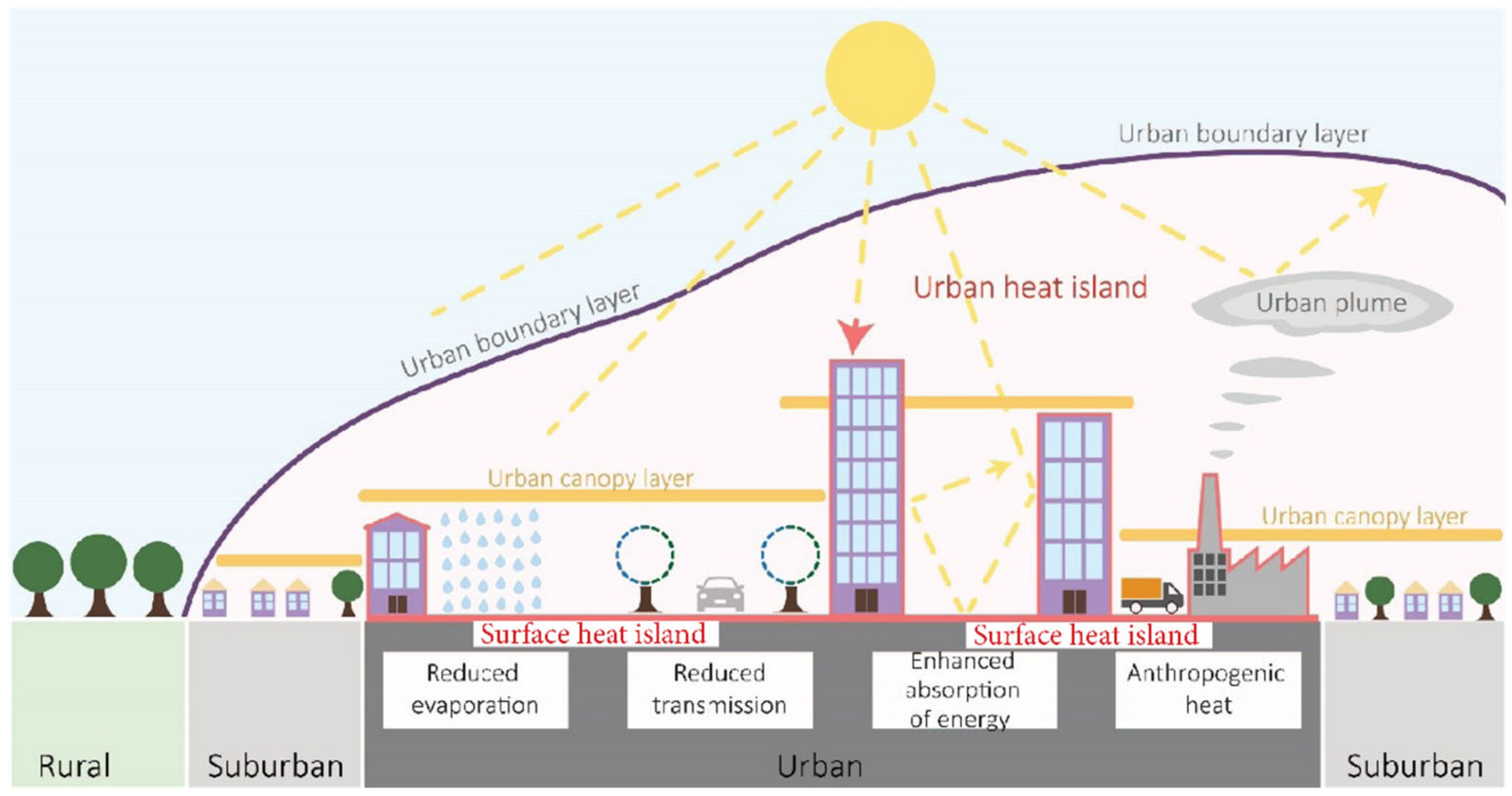

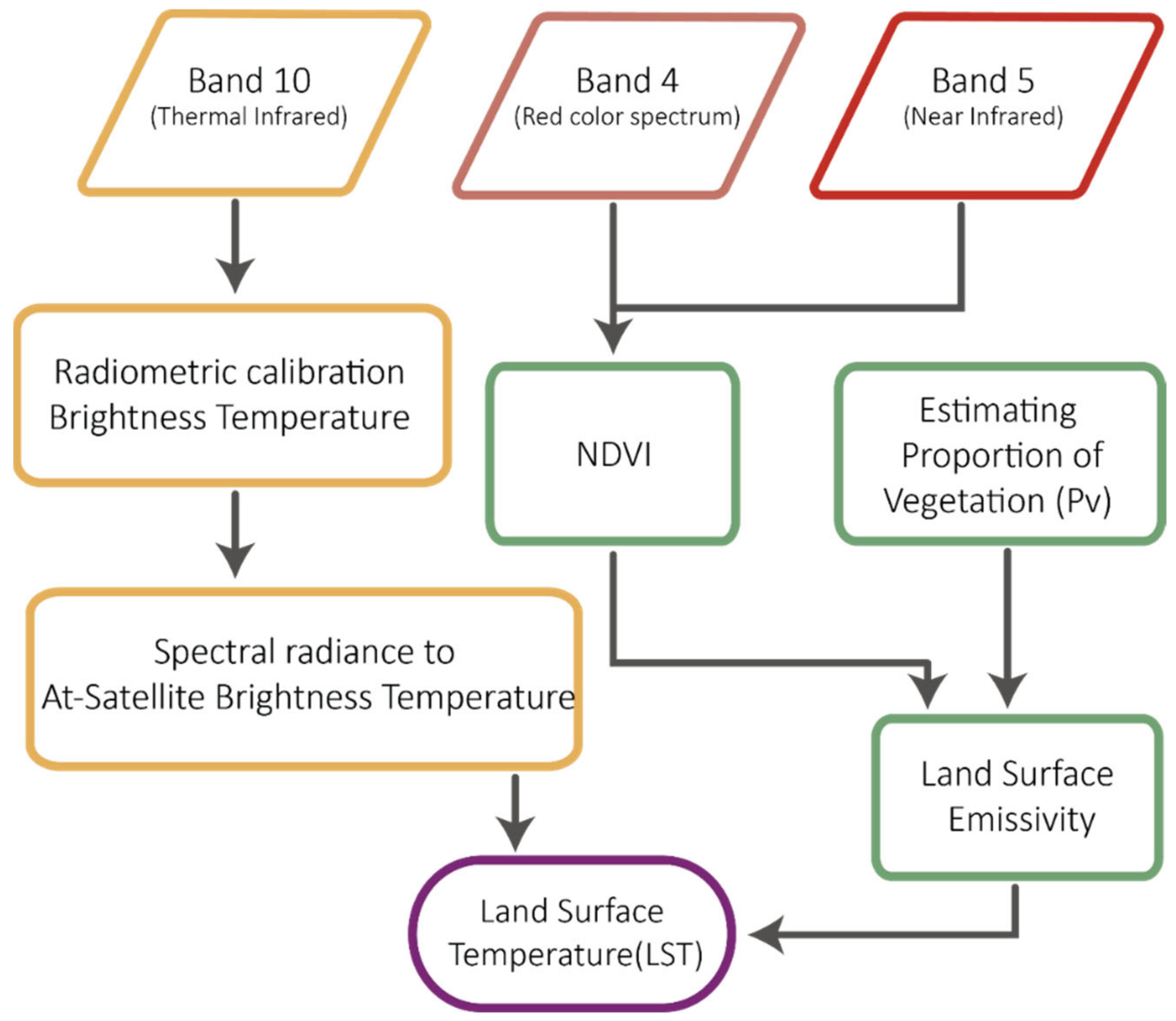



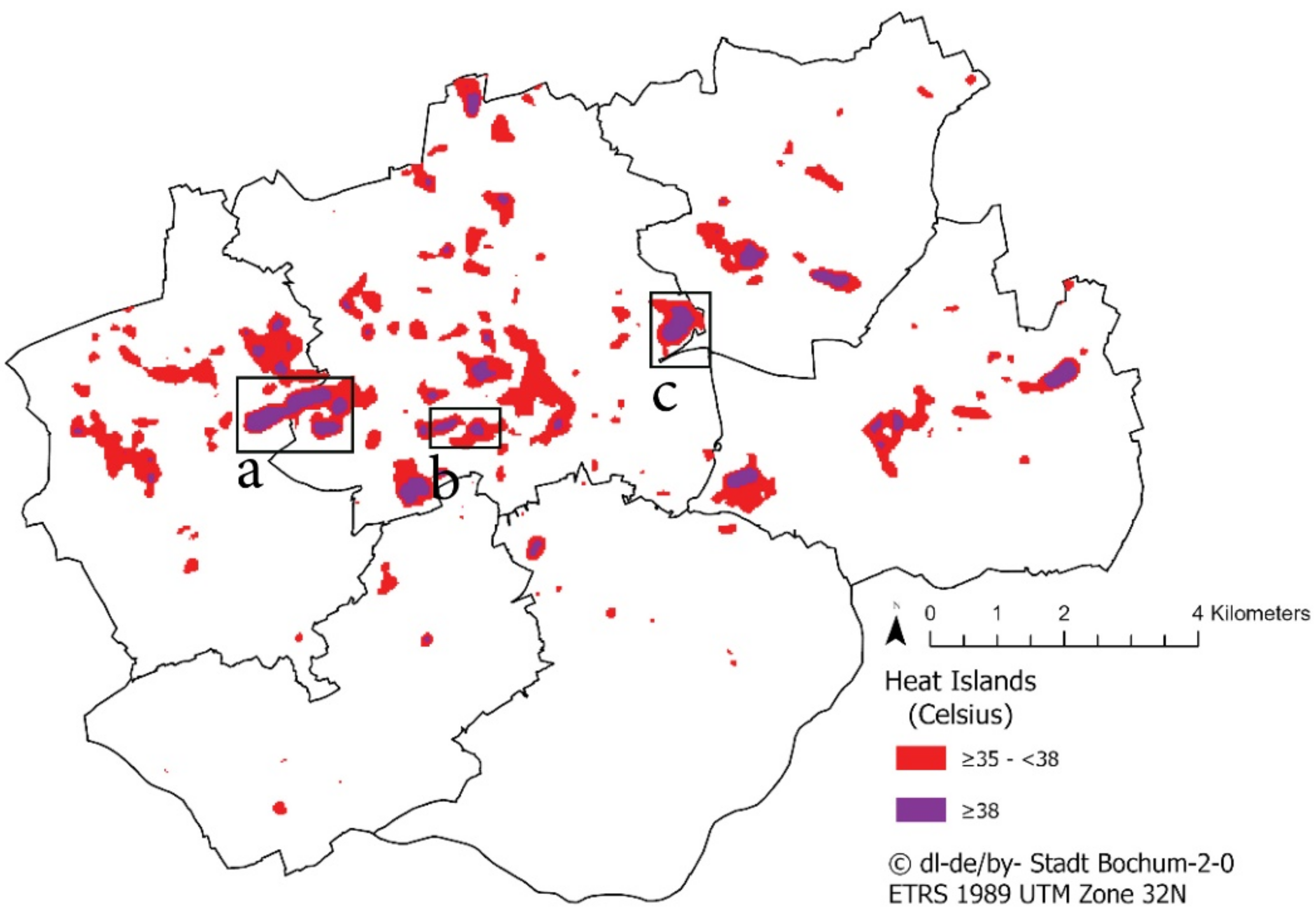
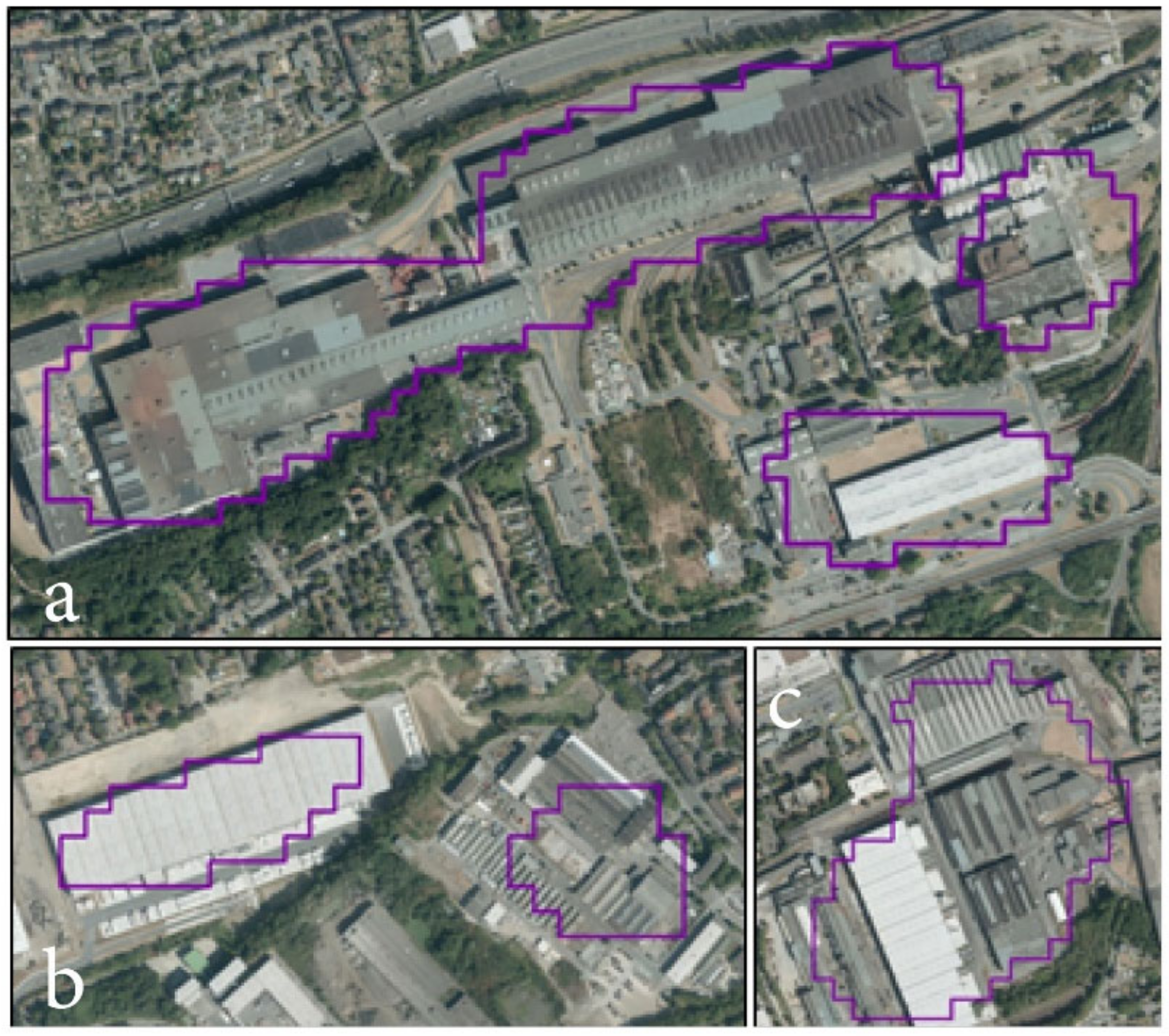


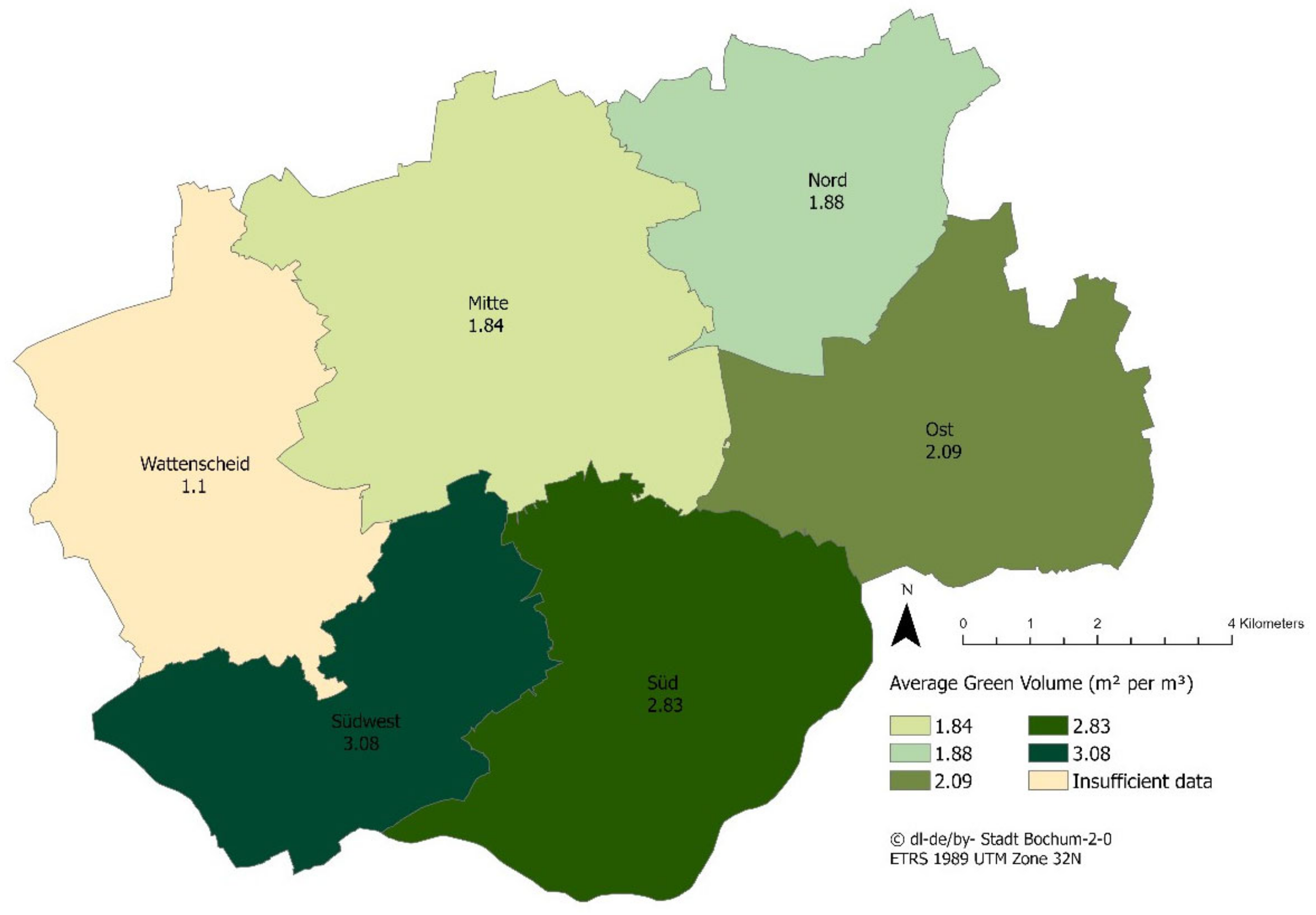
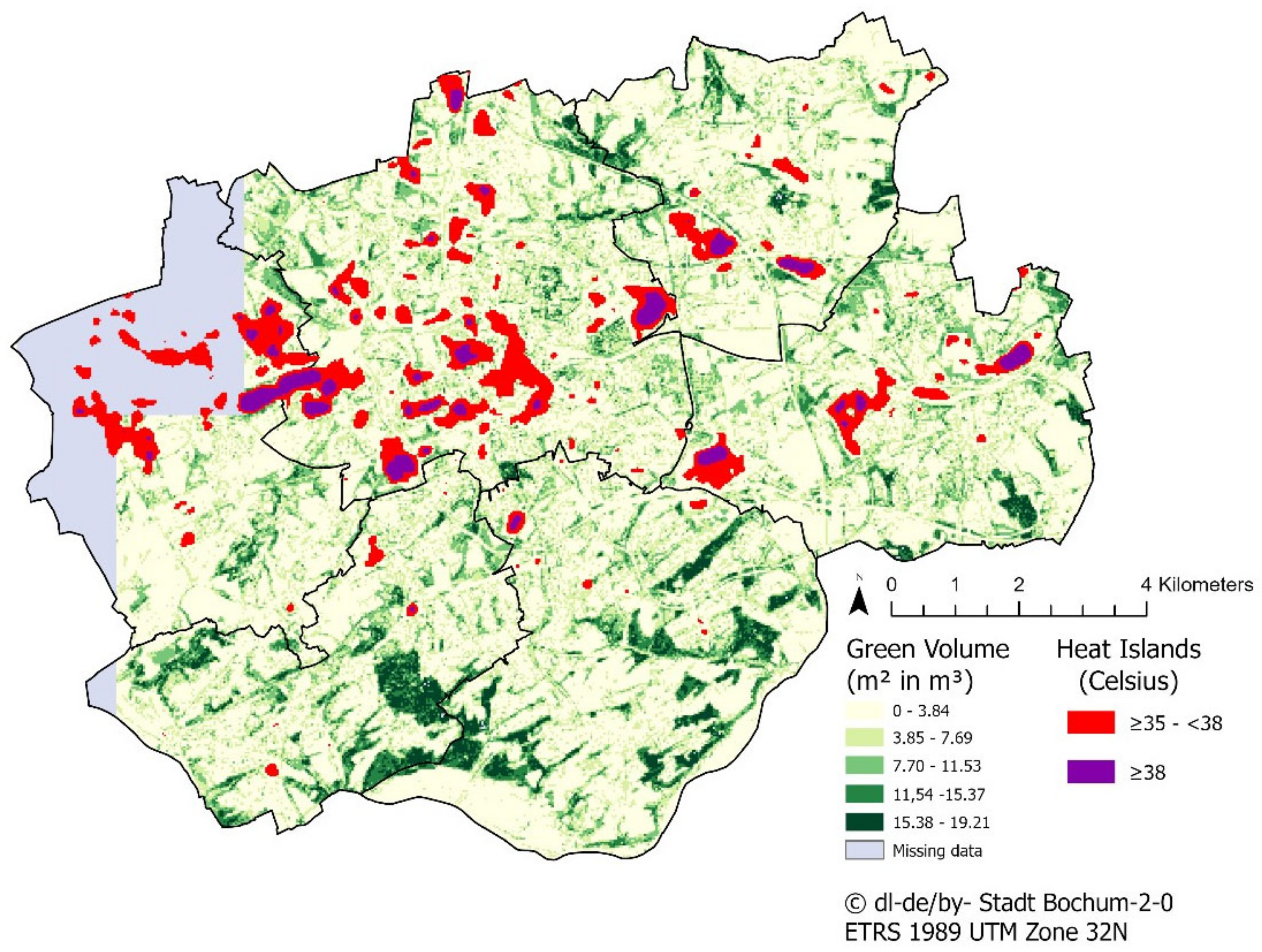


Publisher’s Note: MDPI stays neutral with regard to jurisdictional claims in published maps and institutional affiliations. |
© 2022 by the authors. Licensee MDPI, Basel, Switzerland. This article is an open access article distributed under the terms and conditions of the Creative Commons Attribution (CC BY) license (https://creativecommons.org/licenses/by/4.0/).
Share and Cite
Schmidt, P.; Lawrence, B.T. Association between Land Surface Temperature and Green Volume in Bochum, Germany. Sustainability 2022, 14, 14642. https://doi.org/10.3390/su142114642
Schmidt P, Lawrence BT. Association between Land Surface Temperature and Green Volume in Bochum, Germany. Sustainability. 2022; 14(21):14642. https://doi.org/10.3390/su142114642
Chicago/Turabian StyleSchmidt, Pauline, and Bryce T. Lawrence. 2022. "Association between Land Surface Temperature and Green Volume in Bochum, Germany" Sustainability 14, no. 21: 14642. https://doi.org/10.3390/su142114642
APA StyleSchmidt, P., & Lawrence, B. T. (2022). Association between Land Surface Temperature and Green Volume in Bochum, Germany. Sustainability, 14(21), 14642. https://doi.org/10.3390/su142114642









